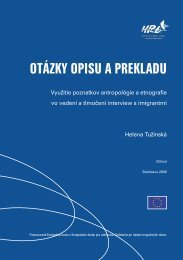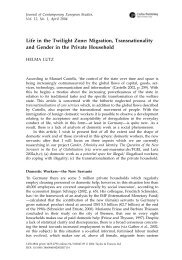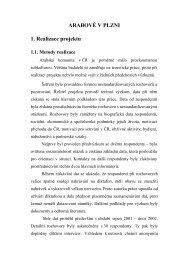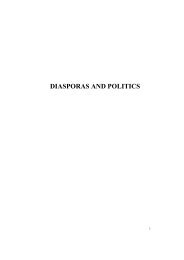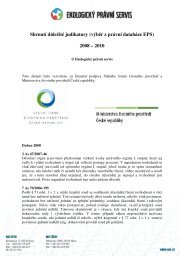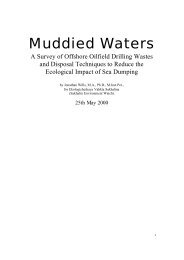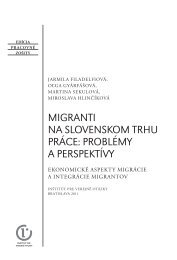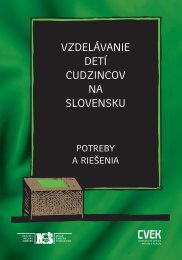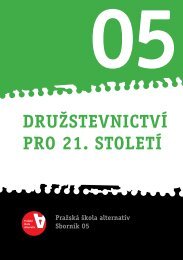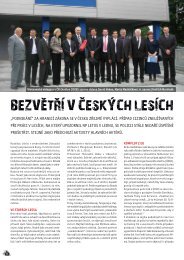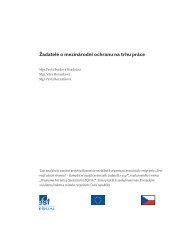Migration Processes in Central and Eastern Europe - Multiple Choices
Migration Processes in Central and Eastern Europe - Multiple Choices
Migration Processes in Central and Eastern Europe - Multiple Choices
Create successful ePaper yourself
Turn your PDF publications into a flip-book with our unique Google optimized e-Paper software.
———————————————————————————————————————————————————————————————<br />
Construction of Borders <strong>and</strong> Practices of Labour <strong>Migration</strong><br />
———————————————————————————————————————————————————————————————<br />
16<br />
—————————————————————————————<br />
Cop<strong>in</strong>g with Visas:<br />
Notes on the<br />
Recent Changes <strong>in</strong><br />
Mobility Regime<br />
at the Romania-<br />
Serbia Border 1<br />
—————————————————————————————<br />
Cosm<strong>in</strong> Radu<br />
Focus<strong>in</strong>g on the border between Romania <strong>and</strong><br />
Serbia, this paper aims to compare the different<br />
border cross<strong>in</strong>g regimes. The border is characterised<br />
by <strong>in</strong>creased territorial mobility of persons<br />
<strong>and</strong> goods. Even before 1989, when cross-border<br />
economic exchanges were formally prohibited for most<br />
of the citizens of the socialist state <strong>and</strong> the circulation was<br />
reduced to a m<strong>in</strong>imum, the contacts between border<br />
communities on each side of the Romania – Serbia border<br />
were extremely <strong>in</strong>tense. Under socialism, people used border<br />
cross<strong>in</strong>gs between these two countries as a way to cope with<br />
the system's shortcom<strong>in</strong>gs, such as shortages of consumer<br />
goods. Travell<strong>in</strong>g for short periods to Serbia or Romania,<br />
formally allowed by the issu<strong>in</strong>g of special permits for small-scale<br />
cross-border traffic (locally named pas de mic trafic), became<br />
a central feature of the household economy. Even if the trips<br />
to Serbia were usually very short, they were still able to<br />
provide access to various rare goods, whilst l<strong>in</strong>k<strong>in</strong>g the<br />
communities <strong>in</strong> each country through various social relations<br />
that cont<strong>in</strong>ued to be very useful after 1989.<br />
After 1989, the border was successively opened<br />
<strong>and</strong> regularised. Almost immediately after the open<strong>in</strong>g, <strong>and</strong><br />
to an even larger extent after the drop <strong>in</strong> <strong>in</strong>dustrial employment<br />
opportunities (especially at the hydropower cascades<br />
on the Danube Iron Gates I <strong>and</strong> II), people relied on cross<strong>in</strong>g<br />
the border to f<strong>in</strong>d better seasonal jobs, mostly <strong>in</strong> the<br />
villages <strong>and</strong> towns just <strong>in</strong>side Serbia. In 2004, the <strong>Europe</strong>an<br />
Union applied pressure <strong>in</strong> an attempt to formalise <strong>and</strong><br />
modernise the border controls. On 1st of July 2004 a restrictive<br />
regime of visas came <strong>in</strong>to force. Along with the compulsory<br />
visas for each border cross<strong>in</strong>g, no matter how short the<br />
stay, <strong>Europe</strong>anisation dem<strong>and</strong>ed the professionalisation<br />
of border police <strong>and</strong> customs officers. It was said that the<br />
transformation of the many aspects of border cross<strong>in</strong>g<br />
would greatly affect the border economy, as well as the lives<br />
of several thous<strong>and</strong> border <strong>in</strong>habitants.<br />
This study is based on approximately 40 <strong>in</strong>terviews<br />
undertaken dur<strong>in</strong>g field trips <strong>in</strong> January 2002 <strong>and</strong> July 2004,<br />
to two border villages <strong>in</strong> Romania (Balta Verde <strong>and</strong><br />
Gogosu), as well as two further trips <strong>in</strong> August 2004 <strong>and</strong><br />
April-May 2005 at the Embassy of Serbia <strong>and</strong> Montenegro<br />
<strong>in</strong> Bucharest. The f<strong>in</strong>d<strong>in</strong>gs cover a large range of the<br />
aspects relat<strong>in</strong>g to the border economy. Two different<br />
dynamics have been documented: a formal one, imposed<br />
by policies from “above”, <strong>and</strong> the <strong>in</strong>formal one, namely that<br />
of the networks of employers <strong>and</strong> employees from “below”.<br />
While at the formal level the border became <strong>in</strong>creas<strong>in</strong>gly<br />
restrictive, the stability <strong>and</strong> density of social networks<br />
allowed further developments <strong>in</strong> cross-border mobility.<br />
This paper aims to describe how the Romanian-<br />
Serbian border appears today <strong>and</strong> also how it has been<br />
challenged by the <strong>in</strong>tervention <strong>in</strong> visa regulations, which<br />
came <strong>in</strong>to effect on 1st July 2004. The recent adm<strong>in</strong>istrative<br />
changes were expected to <strong>in</strong>crease the state control over<br />
the people <strong>and</strong> goods circulat<strong>in</strong>g between the two countries<br />
<strong>and</strong> to establish a “safe” frontier. Dur<strong>in</strong>g the summer of<br />
2004, the public <strong>and</strong> the media became very pessimistic<br />
about the demise of the border economy that had developed<br />
from the end of socialism onwards. It had <strong>in</strong>cluded seasonal<br />
migration, small-scale trad<strong>in</strong>g, cross-border marriages <strong>and</strong><br />
common <strong>in</strong>dustrial activity. However, I will argue that<br />
the implications of the new visa regime were far from<br />
expectations <strong>and</strong> that cross border mobility does still exist,<br />
but it has gone underground.<br />
After the fall of the communist regimes dur<strong>in</strong>g<br />
the 1990s, the borders <strong>in</strong> <strong>Europe</strong> were successively opened<br />
<strong>and</strong> closed accord<strong>in</strong>g to political imperatives. The changes<br />
that occurred <strong>in</strong> the area of border regulation created a<br />
space for <strong>in</strong>novation <strong>and</strong> for diverse categories of people.<br />
In this context, the citizens of the former socialist countries<br />
were agents of <strong>in</strong>novation. Along with political factors there<br />
were many social <strong>and</strong> economic aspects that assured cont<strong>in</strong>uity<br />
<strong>in</strong> migration <strong>in</strong> spite of the restrictive visa regimes.<br />
The fall of state socialism <strong>in</strong> <strong>Eastern</strong> <strong>Europe</strong> led<br />
many to predict a mass exodus to the West, however, the<br />
consequent migration forms were extremely diverse. The<br />
dest<strong>in</strong>ations <strong>and</strong> preferences of <strong>Eastern</strong> <strong>Europe</strong>ans were<br />
not only Western <strong>Europe</strong>'s <strong>in</strong>dustrialised countries. These<br />
processes are reflected <strong>in</strong> grow<strong>in</strong>g literature on migration<br />
to <strong>Central</strong> <strong>Europe</strong>an countries. 2<br />
Romania's st<strong>and</strong><strong>in</strong>g as a c<strong>and</strong>idate country for the<br />
<strong>Europe</strong>an Union forced it to implement a series of security<br />
measures at it's eastern <strong>and</strong> southern frontiers. Today,<br />
Romania is seen as a buffer zone, with a strategic role <strong>in</strong><br />
stopp<strong>in</strong>g traffick<strong>in</strong>g from the East or from non-EU associate<br />
<strong>Migration</strong> <strong>Processes</strong> <strong>in</strong> <strong>Central</strong> <strong>and</strong> <strong>Eastern</strong> <strong>Europe</strong>: Unpack<strong>in</strong>g the Diversity



